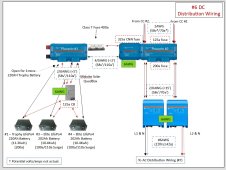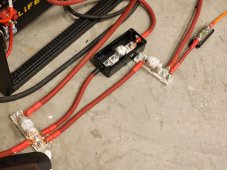@AHTrimble please post your updated topology and I will critique it.
As I said before the whole topology has to be considered.

@AHTrimble please post your updated topology and I will critique it.
As I said before the whole topology has to be considered.

Get rid of the circuit breaker box between the lynx power-in and the batteries.
That is only part of the mission.
The other mission is to protect the wire which means the fuse must be at the battery.
The most important mission is protect the battery from a dead short.
Nobody wants an electrolyte volcano.
Nope I can't.I hear ya! As a retired firefighter...well, you can guess it from there.
Use a small wire try for <8 inches.Problem is...I have no way to connect a fuse at the battery terminal. I was leaning towards the MRBF but you pointed out that its AIC isn't good enough. So I am trying to find something.
I already told you to get rid of them.You can see in the topo I have a 125a CB but I would rather have a fuse...or a fuse in addition to the CB.
I don't care what you have seen.And I still haven't seen a system yet with a fuse right on the battery terminal.
Its been discussed at length in this very thread.I also still haven't seen an explanation yet why a Class-T at each of two inverters vs a single Class-T at the busbar.
Yes they have repeatedly.I am no brainiac, by far, but I can understand things...just no one is giving a clear answer or showing pictures.
Do you trust my advice on the matter?Yeah, you can tell I am frustrated. I just want to get this right...and understand what I am doing.
I’m ordering longer bolts, but this should give you an idea what it will look like:
View attachment 139160
Get rid of the circuit breaker box between the lynx power-in and the batteries.
Use a 250 amp class t fuse as close as possible to each battery positive terminal
Get rid of the class t fuse between the power in and the shunt
Connect the the backplane of the lynx power-in to the lynx_shunt
Use this fuse in the lynx shunt
Littelfuse 0CNN800E.V CNNE Series, Very Fast Acting Fuse, 800A | Waytek
Littelfuse 0CNN800E.V CNNE Series, Very Fast Acting Fuse, 800A, 80VDC is in stock and ready to ship. Order today!www.waytekwire.com
If you have specific questions I will do my best to answer them.
I’m ordering longer bolts, but this should give you an idea what it will look like:
View attachment 139160
Nope I can't.
Just assume I'm not from this planet.
I already told you to get rid of them.
I don't care what you have seen.
Its been discussed at length in this very thread.
re-read all my posts and all by @upnorthandpersonal
Yes they have repeatedly.
Do you trust my advice on the matter?
The batteries have smart BMSs which you can use for administrative disconnect.First off...THANK YOU !!!! I am not a dummy, but I don't know the deep technical stuff like what we are talking about. You taking the time to help me out, and educate me, is incredibly kind of you.
I am using the CB box as a battery disconnect since 2 of the 3 batteries don't have a CB of their own. I wanted to be able to isolate each battery in the start up process. Can you tell me what I gain by getting rid of the CB box?

It stops that fuse from getting in the way.Right now, I already upgraded the 325a to a 400a CNN fuse. What is the benefit to an 800a?
Understood.The 325a/400a was to protect the 4/0 cable.
see above ^I know I wouldn't need that amp rated fuse now since the 4/0 is eliminated, but why 800a?
Yes.Because the Lynx busbars are rated to 1000a?
4 batteries each with 250 amp fuse is 1000 aggregate fault amps.And since each battery would now have a 250a fuse...ok, my head hurts.
Using 2/0 in from batteries and 4/0 out to inverters. Most the fuse should see is less that .4C (40 amps)Please keep in mind those fuses can get pretty warm/hot under normal operation.
So basically you are just substituting a Class-T where the MEGA would go. Did you have to modify the class-t holes, etc?
Where did you source your fuses?
As long as you are using an appropriate insulation (RHW or equivalent) and you have under ~6' of cable... and aren't doing something stupid like running it in a length of EMT with sharp edges your chances of a bolted fault are near-zero. A lower-level fault might be possible, but the protection from that is really in the BMS.That is only part of the mission.
The other mission is to protect the wire which means the fuse must be at the battery.
Bottom line is I don't trust BMSs, and I see any un-protected wire as a danger that can and should be avoided.As long as you are using an appropriate insulation (RHW or equivalent) and you have under ~6' of cable... and aren't doing something stupid like running it in a length of EMT with sharp edges your chances of a bolted fault are near-zero. A lower-level fault might be possible, but the protection from that is really in the BMS.
In a dead short scenario, if the BMS fails I think its between possible and probable that all the FETs will fail nearly simultaneously.The BMS makes the battery essentially a current-limited source.
I can't agree, at least when it comes to server rack batteries.The battery's UL listing is what makes it "safe" as a component.
Do you mean 6 inches?and you have under ~6' of cable.

Does that mean you trust the server rack battery breakers to protect the individual batteries?This isn't very pretty, but I use t class fuses to separate each server rack tower from each other. So each one is handling 30-50kWh of LiFePO4 each:
View attachment 139199
Two were prototypes, the black case one I ordered for another project. But you get the idea. If there is a dead short on one tower, it will be stopped pretty quickly.
When you parallel massive batteries, you need that high AIC rating to avoid 10,000's of Amps of current from flowing. This is how I do it.
I really need to make it more pretty and use a proper bus bar for distribution. This is why I never put this in the videos.


